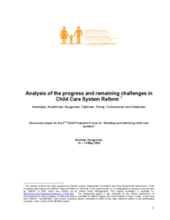The present analysis has been developed by the UNICEF Regional Office for Central and Eastern Europe/Commonwealth of Independent States as a discussion paper for the 2nd Child Protection Forum on Building and Reforming Child Care Systems. It relied heavily on an independent evaluation commissioned by UNICEF in 2007 which was carried out by Oxford Policy Management and is also informed by the official submissions of Governments on recent changes in child care reform.
The countries of Central Asia and Azerbaijan reviewed in this analysis (Azerbaijan, Kazakhstan, Kyrgyzstan, Tajikistan, Turkey, Turkmenistan and Uzbekistan) were all previously republics of the former Soviet Union and gained independence simultaneously in 1991. During the Soviet period, all countries in the region inherited a centralized planned and budgeted child care system that relied largely on institutionalisation of children as a protection measure for children without parental care, in cases of child abuse and neglect and for children with disabilities. Some forms of adoption and alternative family based care, mainly in the form of guardianship were also available on a smaller scale in several of the countries. The system is a legacy of the Soviet state policy that was based on priority of public interests over the private ones, and vested the primary responsibility for raising the children in the state, considering the parents first of all as a labour force. Such approach led to isolation of children in unfavourable situation such as deprivation of parental care, disability or delinquency. The system itself encouraged parents to leave children for alternative care, undermining parental responsibility.
Between 1992 and 1994 all countries covered by this analysis ratified the UN Convention on the Rights of the Child and thereby accepted the obligation to devise a system that would serve children’s best interests, and respect children as subjects of rights, rather than mere objects of care. The child care system reform takes place in this context and is a process which needs to redefine, clarify and enforce the core responsibilities of the State, diversifying different types of services, and introduce the necessary changes in the system regulators, such as policy- and legal frameworks, planning, financial flows and budgeting, professionals, governance bodies, quality assurance systems (such as standards, certification and inspection mechanisms) to reflect modern approaches of family based care for children.
Today, as compared to other parts of the world, CEE/CIS countries still have high rates of children in alternative care. In 2006-2007 there were more than 230,000 children in the region who were living in any type of alternative care arrangements. Approximately 160,000 children were growing up in residential care. Poverty and disability are important factors which push families to use the available child care services. Furthermore, the proportion of children who live in residential care (69%), as compared to alternative family based care (31%), remains almost unchanged. This means that the development and diversification of alternatives to institutionalization is yet to happen in all of the countries.
Despite of the initiation of reforms which are taking place with significant variations in terms of focus and results in all the countries, there are some common characteristics of the child care system which are useful to stress as the fact that these countries share a common “basics” mean that there is also a huge potential to learn from each other’s experiences. In all countries the functions of the child care systems are still mainly carried out by the provision of different types of residential care (baby homes, orphanages, boarding schools etc) There are several sectors involved in the management of the system (typically ministries of education, health and social protection) and supervising different types of services at local level (mainly residential institutions). There are mainly three levels of governance (national, regional and local) involved in the system. There is not much coordination between these sectors and levels, although this is an issue that has been identified in the reform and where attempts to improve coordination are being made.
The most significant achievement in reforms in these countries so far, is perhaps the improvements made in policy and legislative frameworks. These are now clearly favoring support to biological families and to children at risk, prioritize alternative family based care over residential care and favor a reform of institutions. The pace of change varies between countries on account of differing political, economic and social circumstances. There are legal changes to streamline national legislation with standards set up in the Convention on the Rights of the Child. Several countries have enacted new Family Codes, along with adopting and amending other laws and by-laws. The importance of child care as a public policy matter is acknowledged by all six governments. Policy development on the wider issues of social protection and poverty reduction is on the political agenda everywhere.

